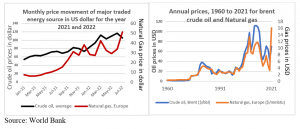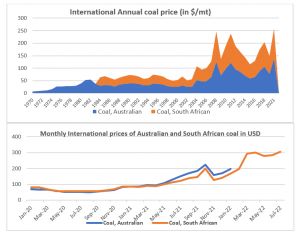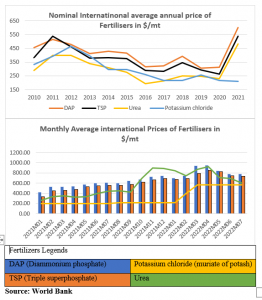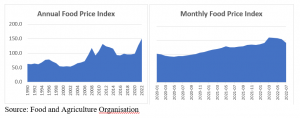
The disruption caused by the Covid-19 pandemic has adversely affected the global energy market. The fragile post-Covid recovery came under tremendous pressure when Russia invaded Ukraine in February this year. The crisis was accentuated by extreme weather events triggered by climate change. This twin crisis not only disrupted the global supply chains, but also led to significant shifts in the global energy sector towards coal-based energy. The major reason for this shift was disruption in oil and gas supplies and the resultant price rise.
The unprecedented rise in temperature and extended heatwaves across the world led to an increase in power demand. The drought conditions led to the drying up of rivers and reservoirs and affected the hydel power generation, while the shift fueled inflationary pressure across economies with commodity prices accounting for most of this rise. The long-term implications are alarming — elevated prices resulting in food security risks and social unrest. The spike in energy prices needs to be tackled on priority and this will require a fundamental shift in our energy portfolio.
READ I Global climate change report highlights urgent need for emissions cut
Brent crude breached the psychological barrier of $100 per barrel in March 2022 and touched $120 per barrel in June, its highest level since 2013. Similarly, natural gas prices surpassed the historic high reached in 2021 and continued their upward journey in 2022. Natural gas price skyrocketed by around 600% in March 2022 compared with the prices a year ago. The prices rose 300% in July 2022 over the same month last year.

The spike in gas prices comes at a time when many countries such as China, UK, Spain, Germany, France, and India are facing high energy demand because of abnormally high temperatures and associated heat waves. The drought conditions in China and European countries severely affected hydel power capacities. This forced countries to fall back on conventional form of energy, mostly based on coal, leading to increased demand for coal and sharp increase in the price of coal.
As seen in Figure 2, in 2021, the international price of Australian coal peaked to high of $127 per/mt, while South African coal leveled its peak in 2008, at $120 per/mt. International coal prices remain elevated in 2022 with spot price of coal at Australia’s Newcastle port breaching $400 a ton in June 2022.

Energy market disruption and food security
Energy is most critical component for economic development that drives growth in all sectors. Long-term availability of affordable energy sources is crucial to the economic progress of any country and the improvement of standard of living of people. This is especially true for developing countries like India with rising energy needs. Agriculture sector is dependent on the availability of affordable energy generated from fossil fuels, and on energy-intensive inputs such as fertilizers.
According to the FAO, the agri-food chain accounts for around 30% of the world’s total energy demand. In India, energy consumption of agriculture sector rapidly increased since the green revolution. The operations include pumping of water to the field during the sowing, harvesting and drying. Energy is also required for safe storage and transportation of food and agriculture products. Therefore, any disruption in the energy market adversely impacts agriculture sector.
Besides, high energy prices affect agriculture by increasing the cost through a rise in the input costs of farming. The fertilizer industry uses coal and natural gas extensively as inputs. Figure 3 shows how prices of fertilizers shot up after 2020 to reach historic high levels in 2022.
READ I Indian economy not out of the woods yet, despite green shoots

Indirectly, high energy prices lead to an increase in the cost of transportation of agriculture products, thereby making food dearer. Transport sector heavily depends on fossil fuel-based sources of energy. Higher energy price and associated rise in fertilizer and transportation costs translate into higher production costs, and ultimately trickle to food prices. Food availability does not respond instantaneously to food price movements. So, food security is adversely impacted.
During this year, severe heatwaves affected agriculture output across countries. The disruption in energy market and skyrocketing energy prices have made the matter worse. The FAO Food Price Index (FFPI) which measure the change in international prices of a basket of food items reached historic heights in 2022 and remained elevated throughout July 2022.

As fuel costs increased, resultant inflationary pressures pushed cost of living and eroded the purchasing power of people across countries. They were already facing hardships because of the impact of Covid-19 in terms of dented incomes. The situation increased food and energy insecurity.
Dependence of agriculture on fossil fuels
Across the world, the transport sector is heavily dependent on oil and gas for its energy requirements. A third of the power generation worldwide is through coal. India uses fossil fuels to meet a large part of its energy requirements. Fossil-fuel based sources of energy is the mainstay of our energy security. However, they contribute mainly towards climate change by emitting greenhouse gases. Climate change, in-turn, impacts agriculture production. Pre-harvest and post-harvest agri-food chain accounts for 20% of the global GHG emissions per year. The resulting vicious cycle associated with high dependency on fossil fuels may exacerbate poverty in many countries and can have serious repercussion on the progress of the country.
In Sri Lanka, high food and energy prices led to major social and political unrest, pushing the economy into a free fall. The UN in its brief released in August 2022 says, Global impact of war in Ukraine: Energy crisis has empathetically reflected these apprehensions by cautioning against the adverse consequences in terms of extreme food and energy insecurity which can potentially lead to exacerbated social discontent, especially in developing countries.
Countries like India are even more vulnerable as food and fuel prices together make up around 55% of the country’s basket for measuring inflation. Besides, being a major importer of fuel, high fuel price also aggravates the trade deficit of the country.
Moving from vicious to virtuous cycle
Food and fuel insecurity triggered by adverse weather phenomena and the Russia-Ukraine war cannot be ignored as an unfortunate coincidence or a once in the life-time event. There is enough evidence now to infer that these adverse consequences are the new normal associated with climate change. India is also increasingly getting impacted by the climate uncertainty.
India recorded extremely high temperatures in March 2022. The associated heat waves affected the wheat crop adversely in many states and other crops such as chickpea, maize and mustard. Moreover, deficiency of monsoon rainfall in UP, West Bengal, Bihar and Jharkhand has impacted paddy sowing activities and there is apprehension that rice output in 2022-23 may also get affected. The extreme weather events in India pose a challenge for achieving sustainable agricultural growth, putting our food and livelihood security are risk.
Reducing reliance on fossil fuels without compromising on energy security holds the key to food security. This calls for doubling our efforts towards tapping alternate sources of energy and incentivising its use in the agriculture. For instance, solar water pumps, solar dryers, and solar water heater can easily replace conventional machinery. Similarly, storing farm produce also requires energy which can be derived from solar energy. Highly subsidised power provided by many state governments in India to farmers disincentivise consumer to shift to alternate source of energy.
High cost associated with alternative energy was one of the major inhibiting factors for shifting away from fossil fuel-based sources of energy. However, cost of renewables, especially solar, has been witnessing a consistent fall over the years. International Renewable Energy Agency (IRENA) has confirmed the critical role of cost-competitive renewable energy in addressing the objective of meeting growing energy demand.
It has reported that almost two thirds or 163 gigawatts (GW) of newly installed renewable power in 2021 had lower costs than the world’s cheapest coal-fired operations in G20 countries. Besides, solar and wind energy have a short gestation period, making adoption much easier compared with nuclear projects.
Such a shift will help reduce our energy cost and help climate change mitigation. But it will also go a long way to enhance food security by increasing productivity and yield. Countries like India with sufficient sun hours are poised to gain. Shifting to solar energy by agriculture sector will reduce the cost of farmers and enable them to increase investment in the farms.
Renewable energy in agriculture is a win-win combination. A swift shift towards renewables will not only help meet our energy requirements in a cost-effective way, but also will help strengthen food and livelihood security across regions.
The positive economies associated with the shift will boost demand and growth in other sectors as well. Once this process sets in, it will bring into force a virtuous cycle of economic growth and employment that will give a big boost to the economy. The shift away from carbon fuels will help India keep inflation under control and reduce our trade deficit.

